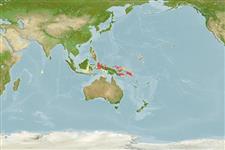Environment: milieu / climate zone / depth range / distribution range
Ecología
marino asociado a arrecife; rango de profundidad 1 - 20 m (Ref. 90102). Tropical
Northeastern Indian Ocean: Nicobar Islands and Western Pacific: Papua New Guinea and the Solomon Islands.
Tamaño / Peso / Age
Maturity: Lm ? range ? - ? cm
Max length : 10.2 cm TL macho / no sexado; (Ref. 90102)
Espinas dorsales (total) : 13; Radios blandos dorsales (total) : 5 - 6; Espinas anales: 3; Radios blandos anales: 5.
Solitary on coral reefs, usually under ledges or in crevices, 1-20 m (Ref 90102).
Life cycle and mating behavior
Madurez | Reproducción | Puesta | Huevos | Fecundidad | Larva
Kailola, P.J., 1987. The fishes of Papua New Guinea: a revised and annotated checklist. Vol. II Scorpaenidae to Callionymidae. Research Bulletin No. 41, Research Section, Dept. of Fisheries and Marine Resources, Papua New Guinea. (Ref. 6192)
IUCN Red List Status (Ref. 130435: Version 2024-2)
Threat to humans
Harmless
Human uses
Herramientas
Special reports
Download XML
Fuentes de Internet
Estimates based on models
Preferred temperature (Ref.
123201): 28.6 - 29.4, mean 28.9 °C (based on 535 cells).
Phylogenetic diversity index (Ref.
82804): PD
50 = 0.5312 [Uniqueness, from 0.5 = low to 2.0 = high].
Bayesian length-weight: a=0.01905 (0.00742 - 0.04894), b=3.01 (2.79 - 3.23), in cm total length, based on LWR estimates for this (Sub)family-body shape (Ref.
93245).
Nivel trófico (Ref.
69278): 3.7 ±0.7 se; based on size and trophs of closest relatives
Resiliencia (Ref.
120179): Alto, población duplicada en un tiempo mínimo inferior a 15 meses (Preliminary K or Fecundity.).
Fishing Vulnerability (Ref.
59153): Low vulnerability (10 of 100).
